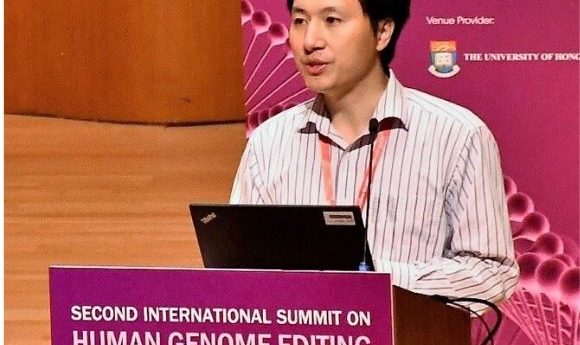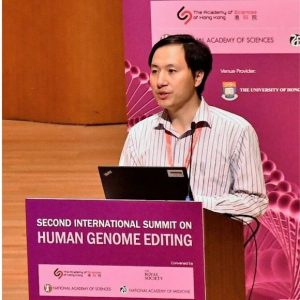Jailing Jiankui: a barrier to progress or a vital verdict?

He Jiankui, the researcher responsible for the CRISPR-edited babies, has been sentenced to 3 years in prison.
When He Jiankui (formerly Southern University of Science and Technology; Shenzhen, China) announced that two babies had been born after the successful in vitro fertilization (IVF) of CRISPR-edited embryos, the scientific community was appalled and its outcry immediate. His experiments had breached the fundamental principles of ethical genetic practice and the slippery slope to ‘designer babies’ seemed to be receiving extra grease.
Now just over a year later, after He’s suspicious absence from any public forum, the biophysicist and founder of multiple genetics companies has been sentenced to 3 years in prison, alongside a hefty 3m yuan ($430,000) fine. The result follows a trial kept private from the public in a court in southern China’s Shenzhen City. He was sentenced alongside fellow researchers Zhang Renli and Qin Jinzhou (both of unnamed medical universities), who received charges of 2 years in prison and a 1m yuan fine and an 18-month suspended sentence and a 500,000 yuan fine, respectively.
But was this initial public outcry and the subsequent sentencing justified? Is there another angle to this story?
He’s work was designed, ostensibly, to enable couples with one partner infected by HIV to have children via IVF that were immune to HIV and therefore would not be born with the virus. The babies were born seemingly healthy and two parents who would otherwise not have been able to have a child now had twins. On the face of it this seems all great news, right?

Well… not quite. As the couples involved in the experiments each consisted of a healthy, HIV free mother and a father with HIV, whose sperm was “washed” to remove HIV, there is no reason why this IVF treatment could not have been administered without a risk of the mother or the developing embryos contracting the virus. Furthermore, there are many ways that healthy individuals can avoid contracting HIV and a few simple precautions could have dramatically decreased the risk of the children catching the disease in later life. Therefore, the CRISPR editing step of the process seems entirely unnecessary to protect the health of the mother or children and instead adds in another step at which complications could occur.
The mutation induced by the He team in the children brings further issues to the fore. A key part of the HIV infection process involves the virus binding to the protein product of the CCR5 gene. This gene is sometimes found mutated in some people, essentially inferring resistance to HIV. He targeted this protein with CRISPR claiming to recreate this natural mutation. However, Fyodor Urnov of the University of California (CA, USA) states that this claim was a “deliberate falsehood” and that the mutation induced in the gene was entirely novel and was likely accompanied by additional mutations at other locations in the genome.
At the time of the experiment, He should have been aware that mutations in CCR5 bear an impact on cognition in mice, making them more intelligent and also improving brain recovery after stroke. The key takeaway from this is not that the twins will be super intelligent, but rather that – as any researcher working on the translation of discoveries and results in animal models into human therapeutics will know – this gene could potentially impact human cognition but with varying differences to the impacts in mice.
What’s more, as discussed in a previous BioTechniques article, mutations in the CCR5 gene have since been shown to bear a 28% increase in the risk of mortality before the age of 78. While this stat may not bear too much impact on the lives of the twins in China, where the average life expectancy is 76, these examples demonstrate the fact that there are a huge amount of unknowns in the effects of the mutations induced in these children. Who can tell what we will discover about the CCR5 gene mutation next?
So, medically, the outcry was more than just; the experiment was unnecessary, had considerable potential to cause harm and was conducted with little information as to the full effects of the procedure.
“He conducted an experiment that had no ethical review board approval, was poorly thought out, could well prove to induce negative effects in the resulting children, deceived the participants and included an act of forgery.”
Further study of He’s conduct, does not much help his case. The Shenzhen court found that He had forged ethics review board papers that were used to recruit couples to the project. One of the victims of this forgery was Bai Hua, the head of HIV advocacy group Baihualin. Hua helped recruit couples for the experiment and now says he feels “deceived.” Study participants have indicated that no discussion regarding the ethics of editing human embryos took place and that assurances were made that there was a low likelihood of a baby being unhealthy, an assurance that simply could not be supported by any concrete evidence.
The manipulation of vulnerable study participants with the promise of IVF in exchange for their participation in the study and the promise of healthy babies is quite staggering in its callousness.
He conducted an experiment that had no ethical review board approval, was poorly thought out, could well prove to induce negative effects in the resulting children, deceived the participants and included an act of forgery. The only useful information to be gleaned from this experiment is the fact that editing in human embryonic genomes can be successfully conducted and the children brought to term, a fact that was previously all but established. However. crucially it does not indicate whether or not it can be done safely and completely bypasses discussion of whether such steps should ever be taken at all.
In light of this, what could He possibly have been trying to achieve by conducting this relatively simple experiment, previously untested, not due to a lack of capability but due to well-established safety protocols and ongoing ethical debate? It is hard to see it as anything other than one man’s race to seize the mantle of ‘The first man to conduct genetic engineering in humans’.
He took a risk in trying to hurdle the ethical debate around human genome editing and has landed himself in deep water and potentially endangered two children in the process, gambling not just with his own future but also the lives of others. His sentence is not only proportionate, it is entirely deserved.